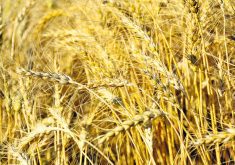The chance of an El Nino developing during the Northern Hemisphere summer is increasing, according to the U.S Climate Prediction Center.
The question is, will an early El Nino impact Canadian spring wheat yields?
On April 17, the CPC put the chances of an El Nino developing in May-to-July at 62 percent, raising the potential for the trend to affect global weather in ways we have not seen in eight years, which was the last time El Nino was present. By the June-to-August period, there is a 75 percent chance of an El Nino.
El Nino and La Nina are the two ends of the trend in the equatorial Pacific waters that swings from warmer to cooler levels.
When the warmer water is in the western Pacific, it is La Nina and when it is in the eastern part of the ocean, it is El Nino. The warm water increases evaporation leading to thunderstorms that can shift where the jet stream flows, affecting weather over large parts of the globe.
The most common and obvious impacts are for La Nina to bring dry weather to parts of South America and wet weather to Australia, while El Nino has the opposite effect.
We were in the La Nina part of the cycle the past few years and it played true to form. Excellent moisture in Australia produced a record wheat crop, while Argentina suffered a devastating drought.
Bryce Anderson of the American publication DTN-Progressive Farmer recently looked at U.S. corn yields in years that appear similar to what is developing this year in terms of El Nino.
He drew on data gathered by long-range forecaster Nathan Hamblin, who identified five years that are analogs for this year: 1951, 1953, 2002, 2006 and 2009. El Nino was building in each of those years.
In 2006 and 2009, U.S. corn crops had excellent average yields, well above the trend line.
However, 2002’s yield was the poorest of the decade.
Going back to the 1950s, the average yield in 1951 was lower than the previous two years. The yield in 1953 was lower than in 1952 but a bit better than 1954.
So some of the El Nino years had excellent yields but others didn’t, so there is not a lock tight correlation.
Let’s now look at Canadian wheat yields for the same El Nino years.
In 2002, the spring wheat average yield in Canada was poor at only 25.7 bushels per acre. Drought was a major problem in 2001 and 2002.
The average yield in 2006 at 37 bu. per acre was lower than the previous two years but not bad for the era.
A couple of years later, there was significant improvement in yields with introduction of new, more robust varieties.
The average yield in 2009 was 41.2, about normal for that era.
It is interesting to note that average yields again jumped higher, into the low 50s, beginning with the introduction of AAC Brandon in 2015 followed by AAC Viewfield and AAC Starbuck.
Drought brought another poor yield in 2021, which was a La Nina year.
Looking back into the analog years of the 1950s, the average spring wheat yield in 1951 was better than the previous two.
The following year had excellent yields but in analog year 1953, it fell back a little, though was still good at 23.8 bu. per acre.
But 1954, which was the tail end of the 1953-54 El Nino, was devastating with a yield of only 12.5 bu.

From this data, except for the bad year of 2002, Canadian spring wheat yields in the analog El Nino years were about normal for varieties that dominated in those eras.
The break from the three-year La Nina and shift toward El Nino has for now had a bigger impact on the southern and southwestern United States and countries south of the equator.
The long-term drought in California and mountain states is broken. There are concerns about flooding but the heavy snow pack in the western mountains will be important to partially addressing the water shortages there.
It is still dry in hard red winter wheat areas in Kansas, Oklahoma and northern Texas. But as I write this April 21, there is a forecast for significant rain to fall from April 25-27 . A lot of damage has already been done but the moisture will be welcome.
Australian forecasters expect drier and warmer than normal conditions in May to July.
The huge second corn crop in Brazil is enjoying mostly favourable conditions except for the dry southern most states.

















